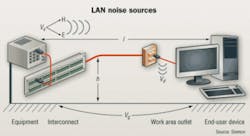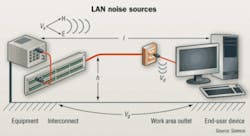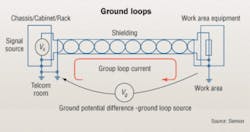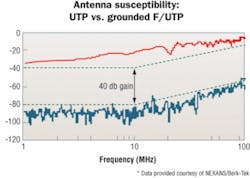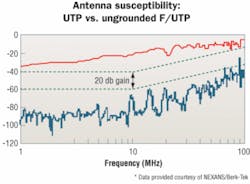The myths and realities of shielded, screened cabling
Potential users must separate fact from fiction concerning noise immunity, grounding, and the antenna effect.
A global standard since the 1980s, screened and shielded twisted-pair copper cabling varieties are still a mainstay in some markets. While many other markets have migrated largely to unshielded twisted-pair (UTP) cables, the recent ratification of the 10GBase-T standard for 10-Gbit/sec Ethernet over copper has re-established the commercial viability of screened and shielded systems, and has fueled greater adoption of these systems in markets that previously were UTP-centric.
In this competitive landscape, many confusing and often contradictory messages are finding their way to the marketplace. This article addresses common questions, issues, and misconceptions regarding screened and shielded cabling.
From Token Ring to Ethernet
When LAN cabling emerged in the 1980s to support the first computer networks in commercial building space, the networks typically deployed IBM Token Ring transmission, which was standardized as IEEE 802.5 in 1985. Cabling for Token Ring networks was IBM Type 1 cable-consisting of two loosely twisted, foil-shielded, 150-Ω pairs surrounded by an overall braid-mated to unique hermaphroditic connectors.
This cabling was an optimum choice for support of first-generation LAN topologies. Its design took advantage of the twisted-pair transmission protocol’s ability to maximize distance (Token Ring served distances up to 100 meters) and data rates using cost-effective transceivers. The foils and braid improved crosstalk and electromagnetic compatibility (EMC) performance to levels that could not yet be realized by early-generation twisted-pair design and manufacturing capability. It is not surprising that this robust cabling type still supports some buildings today.
By 1990, however, LAN industry experts began to recognize Ethernet’s performance and reliability advantages over Token Ring. Concurrently, twisted-pair design and manufacturing capabilities had progressed to the point where individual foils were no longer required to provide internal crosstalk isolation, and overall shields were not necessary to provide immunity against outside noise sources in the 10Base-T and 100Base-T bands of operation.
Publication of the 10Base-T application in 1990, and the first edition TIA/EIA-568 cabling standard the following year, in conjunction with the lower cost associated with UTP cabling, firmly established UTP as the medium of choice for new LAN networks.
Balancing act
The benefit of specifying balanced twisted-pair cabling for data transmission is clearly demonstrated by examining the types of signals present in building environments. Electrical signals can propagate in either common mode or differential (i.e., “balanced”) mode.
Common mode describes a signal scheme between two conductors in which the voltage propagates in phase and is referenced to ground. Examples of common mode transmission include DC circuits, building power, cable TV, heating/ventilation/air-conditioning (HVAC) circuits, and security devices. Electromagnetic noise induced from disturbers, such as motors, transformers, fluorescent lights, and radio-frequency (RF) sources, also propagates in common mode. Virtually every signal and disturber type in the building environment propagates in common mode, with one notable exception- twisted-pair cabling, which is optimized for balanced, or differential mode, transmission.
Differential mode transmission refers to two signals that have equal magnitudes, but are 180° out of phase, and that propagate over two conductors of a twisted pair. In a balanced circuit, two signals are referenced to each other rather than one signal being referenced to ground. There is no ground connection in a balanced circuit and, as a result, these types of circuits are inherently immune to interference from most common mode noise disturbers.
In theory, common mode noise couples equally onto each conductor of a perfectly balanced twisted-pair. Differential mode transceivers detect the difference in peak-to-peak magnitude between the two signals on a twisted pair by performing a subtraction operation. In a perfectly balanced cabling system, the induced common mode signal would appear as two equal voltages that are simply subtracted out by the transceiver, thereby resulting in perfect noise immunity.
In the real world, however, twisted-pair cables are not perfectly balanced, and their limitations must be understood by application developers and system specifiers.
TIA and ISO/IEC committees take extreme care in specifying balance parameters, such as transverse conversion loss (TCL), transverse converse transfer loss (TCTL), and equal-level transverse converse transfer loss (ELTCTL) in their standards for higher-grade (Category 6 and above) structured cabling. By examining the performance limits for these parameters and noting when they start to approach the noise isolation tolerance required by various Ethernet applications, it becomes clear that the practical operating bandwidth (defined by acceptable levels of common mode noise immunity due to balance) is approximately 30 MHz.
While this bandwidth provides more than sufficient noise immunity for such applications as 100Base-T and 1000Base-T, Shannon Capacity modeling demonstrates that this level provides no headroom to the minimum 10GBase-T noise immunity requirements. The use of shielding, however, significantly improves noise immunity, doubles the available Shannon Capacity, and substantially increases practical operating bandwidths for future applications.
Noise and immunity
Modal conversion is an effect of degraded twisted-pair signal balance above 30 MHz, which occurs when differential mode signals convert to common mode signals, and vice versa. The conversion can adversely impact noise immunity from the environment as well as contribute to crosstalk between pairs and balanced cables, and must be minimized whenever possible. Shielding can decrease the potential for modal conversion by limiting noise coupled onto the twisted-pair from the environment.
All applications require positive signal-to-noise ratio (SNR) margins to transmit within allocated bit error rate (BER) levels. This means that the data signal being transmitted must be of greater magnitude than all of the combined noise disturbers coupled onto the transmission line-i.e., the structured cabling.
Noise can be coupled onto twisted-pair cabling in any or all of three ways.
- Differential noise: Noise induced from an adjacent twisted-pair or balanced cable;
- Environmental noise: Noise induced by an external electromagnetic field;
- Ground loop noise: Noise induced by a difference in potential between conductor ends.
Different applications have varying sensitivity to interference from these three noise sources, depending upon their capabilities. For example, the 10GBase-T application is commonly recognized to be extremely sensitive to alien crosstalk (differential mode cable-to-cable coupling) because its digital signal processing (DSP) capability electronically cancels internal pair-to-pair crosstalk within each channel. Unlike pair-to-pair crosstalk, alien crosstalk cannot be cancelled by DSP. Conversely, because the magnitude of alien crosstalk is very small compared to pair-to-pair crosstalk, the presence of alien crosstalk minimally impacts the performance of other applications, such as 100Base-T and 1000Base-T, that employ partial or no crosstalk-cancelling algorithms.
EMC describes both a system’s susceptibility to interference from, and potential to disturb, outside sources. It is an important indicator of a system’s ability to co-exist with other electronic/electrical devices. Noise immunity and emissions performance is reciprocal, meaning that the cabling system’s ability to maintain immunity to interference is proportional to the system’s potential to radiate. Interestingly, while unnecessary emphasis is placed on immunity considerations, it is understood that structured cabling systems do not radiate or interfere with other equipment or systems in the telecommunications environment.
Here’s a more detailed look at the various noise disturbers:
Differential noise disturbers. Alien crosstalk and internal pair-to-pair crosstalk are examples, and must be minimized through proper cabling-system design. Susceptibility to interference from differential mode sources is dependent upon system balance and can be improved by isolating or separating conductors that are interfering with each other. Cabling with improved balance-Category 6 and above-exhibits better internal crosstalk and alien crosstalk performance. Because no cable is perfectly balanced, strategies such as using dielectric material to separate conductors or using metal foil to isolate conductors are employed to further improve crosstalk performance. For example, Category 6A F/UTP cabling is proven to have substantially superior alien crosstalk performance than Category 6A UTP cabling because its overall foil construction reduces alien crosstalk to virtually zero. Category 7 S/FTP is proven to have substantially superior pair-to-pair and alien crosstalk performance than any Category 6A cabling design because its individual foiled twisted-pair construction reduces pair-to-pair and alien crosstalk coupling to virtually zero. These superior crosstalk levels could not be achieved solely through compliant balance performance.
Environmental noise disturbers. Environmental noise is electromagnetic noise made up of magnetic fields generated by inductive coupling, and electric fields generated by capacitive coupling. Magnetic field coupling occurs at low frequencies, such as 50 or 60 Hz, where the balance of the cabling system is more than sufficient to ensure immunity. Its impact can be ignored for all types of balanced cabling. Electric fields, however, can produce common mode voltages on balanced cables depending on their frequency. The magnitude of the voltage induced can be modeled, assuming that the cabling system is susceptible to interference in the same manner as a loop antenna.
Mathematical formulas demonstrate that a 60-Hz signal results in an electric field disturbance that can only be measured in the thousands-of-mV (millivolt) range, while sources operating in the MHz range can generate a fairly large electric field disturbance. For reference, 3 Volts/meter (V/m) is considered to be a reasonable approximation of the average electric field present in a light industrial/commercial environment, and 10 V/m is considered to be a reasonable approximation of the average electric field present in an industrial environment.
The loop area is the one variable that impacts the magnitude of the voltage coupled by the electric field. Common mode currents generated by an electric field induce unwanted signals on the outermost conductive element of the cabling-the conductors themselves in a UTP environment, and the overall screen/shield in a screened/fully shielded environment.
Again, through the means of calculations, what becomes readily apparent is that the common mode impedance is not very well controlled in UTP environments. This impedance depends on factors such as distance from metallic raceways, metallic structures surrounding the pairs, use of non-metallic raceways, and termination location. Conversely, this common mode impedance is well defined and controlled in screened/shielded cabling environments.
Importantly, the overall susceptibility of twisted-pair cables to electric field disturbance depends on both the balance performance of the cabling and the presence of a screen or shield. Well-balanced cables (Category 6 and above) should be immune to electromagnetic interference up to 30 MHz. The presence of a shield or screen is necessary to avoid electromagnetic interference at higher frequencies, which is an especially critical consideration for next-generation applications.
For example, it is reasonable to model that an emerging application using DSP techniques will require a minimum SNR of 20 dB at 100 MHz. Because the minimum isolation yielded by balance alone is also 20 dB at 100 MHz, the addition of a screen or shield is necessary to ensure this application has sufficient noise immunity headroom for operation.
Ground loops. These develop when there is more than one ground connection, and the difference in common mode voltage potential at these ground connections induces noise on the cabling. It is a misconception that common mode noise from ground loops can only appear on screens and shields; this noise regularly appears on the twisted pairs as well. A key point about the voltage generated by ground loops is that its waveform is directly related to the profile of the building’s alternating current (AC) power. In the United States, the primary noise frequency is 60 Hz and its related harmonic, which is often referred to as AC “hum.” In other regions of the world, the primary noise frequency is 50 Hz and its related harmonic.
Because each twisted pair is connected to a balun transformer and common mode noise rejection circuitry at both ends of the circuit-the network interface card (NIC) and the network equipment-differences in the turn ratios and common mode ground impedances can result in common mode noise. The magnitude of the induced noise on the twisted pairs can be reduced, but not eliminated, through the use of common mode terminations, chokes, and filters within the equipment.
Ground loops induced on the screen/shield typically occur because of a difference in potential between the ground connection at the telecommunications grounding busbar (TGB) and the building ground connection provided through the network equipment chassis at the work-area end of the cabling. Note that it is not mandatory for equipment manufacturers to provide a low-impedance building ground path from the shielded 8-pin modular (RJ-45) jack through the equipment chassis. Sometimes, the chassis is isolated from the building ground with a protective RC circuit and, in other cases, the shielded RJ-45 jack is completely isolated from the chassis ground.
Excessive ground loop thresholds
TIA and ISO standards identify the threshold when an excessive ground loop develops as when the difference in potential between the voltage measured at the shield at the work-area end of the cabling, and the voltage measured at the ground wire of the electrical outlet used to supply power to the workstation, exceeds 1.0 Vrms (Volts, root mean square). This difference in potential should be measured and corrected in the field to ensure proper network equipment operation, but values in excess of 1.0 Vrms are very rarely found in countries that have carefully designed and specified building and grounding systems. Furthermore, because the common mode voltage induced by ground loops is low frequency (50 or 60 Hz and their respective harmonics), the balance performance of the cabling plant itself is sufficient to ensure immunity regardless of the actual voltage magnitude.
It is commonly believed that ground loops only appear on screened and shielded cabling systems, but that’s a myth. The fear is that ground loops resulting from a difference in voltage potential between a screened/shielded cabling system’s ground connections cause excessive common mode currents that can adversely affect data transmission. In fact, screens and shields, and the balanced twisted pairs in a UTP cable, are affected by differences in voltage potential at the end of the channel.
The difference in the transformer common mode termination impedance at the NIC and the network equipment naturally results in common mode noise current being induced on each twisted pair. Grounding of the screened/shielded system in multiple locations can result in common mode noise current being induced on the screen/shield; however, these common mode noise currents do not affect data transmission because, regardless of their voltage magnitude, their waveform is always associated with the 50- or 60-Hz profile of the building AC power.
Thanks to the balance of the cabling at low frequencies, common mode currents induced onto the twisted pair, either directly from equipment-impedance differentials or coupled from a screen/shield, are simply subtracted out by the transceiver as part of the differential transmission algorithm.
Grounding and cabling systems
The ANSI-J-STD-607-A-2002 standard defines the building telecommunications grounding and bonding infrastructure that originates at the service equipment (power) ground and extends throughout the building. It is important to recognize that the infrastructure applies to both UTP and screened/ shielded cabling systems.
The standard includes many mandates, including:
- The telecommunications main grounding busbar (TMGB) is bonded to the main building service ground. Actual methods, materials, and appropriate specifications for each of the components in the telecommunications grounding and bonding system vary according to system and network size, capacity, and local codes.
- If used, TGBs are bonded to the TMGB via the telecommunications bonding backbone.
- All racks and metallic pathways are connected to the TMGB or TGB.
- The cabling plant and telecommunications equipment are grounded to equipment racks or adjacent metallic pathways.
TIA and ISO standards provide one additional step for the grounding of screened and shielded cabling systems. Specifically, clause 4.6 of ANSI/TIA-568-B.1 and clause 11.3 of ISO/IEC 11801:2002 state that the cable shield shall be bonded to the TGB in the telecommunications room, and that grounding at the work area may be accomplished through the equipment power connection.
This procedure is intended to support the optimum configuration of one ground connection to minimize the appearance of ground loops, but recognizes that multiple ground connections may be present along the cabling.
When the grounding and bonding recommendations specified in ANSI-J-STD-607-A-2002 were developed, consideration was given to the possibility that grounding at the work area through the equipment cord may occur; therefore, there is no need to specifically avoid grounding the screened/ shielded system at the user’s PC or device. The difference between a ground connection and a screen/shield connection is notable and important. A ground connection bonds the screened/shielded cabling system to the TGB or TMGB, while a screen/shield connection maintains electrical continuation of the cable screen/shield through the screened/shielded telecommunications connectors along the full length of cabling.
Part of the function of the screen or shield is to provide a low-impedance ground path for noise currents that are induced on the shielded material. Compliance to the TIA and ISO specifications for the parameters of cable and connection hardware transfer impedance and coupling attenuation ensures the maintenance of a low-impedance path through all screened/shielded connection points in the cabling system.
For optimum alien crosstalk and noise immunity performance, shield continuity should be maintained throughout the end-to-end cabling system. UTP patch cords in screened/shielded cabling systems should be avoided.
Building end users should perform a validation to ensure that screened and shielded cabling systems are properly grounded to the TGB or TMGB. Here’s a recommended inspection plan:
- Visually inspect to verify that all equipment racks/cabinets/metallic pathways are bonded to the TGB or TGMB using a 6-AWG conductor.
- Visually inspect to verify that all screened/shielded patch panels are bonded to the TGB or TMGB using a 6-AWG conductor.
- Perform a DC resistance test to ensure that each panel and rack/cabinet grounding connection exhibits a DC resistance measurement of <1 Ω between the bonding point of the panel/rack and the TGB or TMGB. (Note: Some local/ regional standards specify a maximum DC resistance of <5 Ω at this location).
- Document the visual inspection, DC test results, and all other applicable copper/fiber test results.
TIA and ISO standards identify the threshold when an excessive ground loop develops as when the difference in potential between the voltage measured at the shield at the work-area end of the cabling, and the voltage measured at the ground wire of the electrical outlet used to supply power to the workstation, exceeds 1.0 Vrms. While this difference in potential should be measured and corrected in the field to ensure proper network equipment operation, values in excess of 1.0 Vrms are very rarely found in countries that have carefully designed and specified building and grounding systems. Furthermore, because the common mode voltage induced by ground loops is low frequency, the balance performance of the cabling plant is sufficient to ensure immunity regardless of the actual voltage magnitude.
Shield design and the antenna myth
Shielding offers the benefits of significantly improved pair-to-pair crosstalk performance, alien crosstalk performance, and noise immunity that cannot be matched by any other cabling design strategy. Category 6A and lower-rated F/UTP cables are constructed with an overall foil surrounding the four twisted pairs. Category 7 and higher-rated S/FTP cables are constructed with an overall braid surrounding four individually foil-shielded pairs. Optional drain wires are sometimes provided.
Shielding materials are selected for their ability to maximize immunity to electric field disturbance, capability to reflect the incoming wave, absorption properties, and ability to provide a low-impedance signal path. As a rule, more conductive shielding materials yield greater amounts of incoming signal reflection.
Solid aluminum foil is the preferred shielding media for telecommunications cabling because it provides 100% coverage against high frequency (greater than 100 MHz) leakage, as well as low electrical resistance when properly connected to ground. The thickness of the foil shield is influenced by the skin effect of the interfering noise currents. Skin effect is the phenomenon in which the noise current’s depth of penetration decreases as frequency increases.
Typical foil thicknesses are 1.5 mils (0.038 mm) to 2.0 mils (0.051 mm) to match the maximum penetration depth of a 30-MHz signal. This design approach ensures that higher frequency signals will not interfere with the twisted pairs as a result of their good balance performance. Braids and drain wires add strength to cable assemblies and further decrease the end-to-end electrical resistance of the shield when the cabling system is properly connected to ground.
A common myth says that screens and shields can behave as antennas because they are long lengths of metal. The fear is that screens can “attract” signals that are in the environment, or radiate signals that appear on the twisted pairs. The fact is that both screens and shields, and the copper balanced twisted pairs in a UTP cable, will behave as an antenna to some degree. The difference is the noise that couples onto the screen or shield is actually 100 to 1,000 times smaller in magnitude than the noise that is coupled onto an unshielded twisted pair in the same environment. This difference is due to the internal pairs’ well-defined and controlled common mode impedance to the ground plane that is provided by the screen/shield.
Here is an analysis of the two types of signal disturbers that can affect the noise immunity performance of balanced twisted-pair cabling:
At frequencies below 30 MHz, noise currents from the environment can penetrate the screen/shield and affect the twisted pairs; however, the magnitude of these signals is substantially smaller (and mostly attenuated due to the absorption loss of the aluminum foil), meaning that unshielded twisted pairs in the same environment are actually subjected to a much higher electric field strength. The good news is that the balance performance of the cable itself is sufficient up to 30 MHz to ensure minimum susceptibility to disturbance from these noise sources, regardless of the presence of an overall screen/shield.
At frequencies above 30 MHz, noise currents from the environment cannot penetrate the screen/shield due to skin effects, and the internal twisted pairs are fully immune to interference. Unfortunately, balance performance is no longer sufficient to ensure adequate noise immunity for UTP cabling at these higher frequencies. This can have an adverse impact on the cabling system’s ability to maintain the SNR levels required by applications employing DSP technology.
The potential for a cable to behave as an antenna can be experimentally verified by arranging two balanced cables in series, injecting a signal into one cable to emulate a transmit antenna across a swept frequency range, and measuring the interference on an adjacent cable to emulate a receiving antenna. As a rule of thumb, the higher the frequency of the noise source, the greater the potential for interference. The coupling between two UTP cables is a minimum of 40 dB worse than the interaction between two properly grounded F/UTP cables. It should be noted that 40 dB of margin corresponds to 100 times less voltage coupling, thus confirming the modeled predictions. The UTP cable radiates and receives-behaves like an antenna-substantially more than the F/UTP cable.
A second antenna myth is that common mode signals appearing on a screen or shield can only be dissipated through a low-impedance ground path. The fear is that an ungrounded screen will radiate signals that are “bouncing back and forth” and “building up” over the screen/shield. In fact, left ungrounded, a screen/shield will substantially attenuate higher-frequency signals because of the low-pass filter formed by its resistance, distributed shunt capacitance, and series inductance.
The effects of leaving both ends of a foil twisted-pair cable ungrounded can also be verified by using the abovementioned experimental method. The coupling between two UTP cables is still a minimum of 20 dB worse than the interaction between two ungrounded F/UTP cables. (Note that 20 dB of margin corresponds to 10 times less voltage coupling.) Even under worst-case, ungrounded conditions, the UTP cable behaves more like an antenna than the F/UTP cable.
Modeled and experimental results clearly dispel these antenna myth. Screens and shields offer substantially improved noise immunity compared to unshielded constructions above 30 MHz, even when improperly grounded.
The performance benefits of using screened and fully shielded systems include:
- Reduced pair-to-pair crosstalk in fully shielded designs;
- Reduced alien crosstalk in screened and fully shielded designs;
- Screened Category 6A cable diameters that are smaller than many 6A UTP cables, allowing greater pathway fill/ utilization;
- Substantially improved noise immunity at all frequencies, and especially above 30 MHz when cable balance starts to significantly degrade;
- Significantly increased Shannon Capacity for future applications.
Fusion of the best
Achievable SNR margin is dependent upon the combined properties of cabling balance and the common mode and differential mode noise immunity provided by screens and shields. Applications rely on positive SNR margin to ensure proper signal transmission and minimum BER. With the emergence of 10GBase-T, it has become clear that the noise isolation provided by good balance alone is just barely sufficient to support transmission objectives. Furthermore, the alien crosstalk and noise immunity benefits provided by F/UTP and S/FTP cabling designs have been demonstrated to offer almost double the Shannon Capacity, a performance advantage that has caught the attention of application developers and system specifiers alike.
It is often said that the telecommunications industry has come full circle in the specification of its preferred media type. In actuality, today’s screened and fully shielded cabling systems represent a fusion of best features of the last two generations of LAN cabling: excellent balance to protect against low-frequency interference, and shielding to protect against high-frequency interference.
(Editor’s note: This article is derived from Valerie Rybinski’s white paper, “Screened and Shielded Cabling: Noise Immunity, Grounding, and the Antenna Myth.” The paper contains information used in this article, as well as a full explanation of the simplified loop antenna model, a complete bibliography of Rybinski’s sources, and a glossary of terms and acronyms. The white paper is available at www.siemon.com.)
